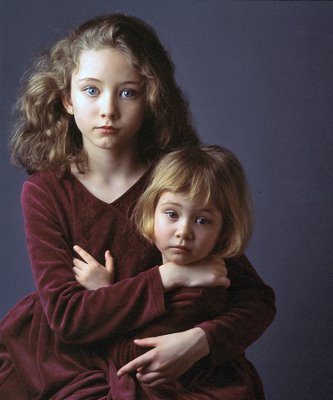Banishing Our Shadows
Wednesday, August 08, 2007

From my bed I find myself looking at this recent framed photograph of Rebecca and Lauren wearing their wine-coloured dresses. I don't try to make these pages a place where I pontificate on the dos and don'ts of photography. But I will note some disturbing (for me) trends. One of them came to mind as I stared at Rebecca and Lauren on the wall.
Flemish painting seemed to glorify God's light which was the light coming through a window. Until the advent of gas and electricity, candles ( Abraham Lincoln used a flickering fire place to read ) and window light where the only lights available. Flemish painters painted all the nuances of window light as it revealed or hid a person's face. These nuances depended on the gentle rotation of the face in relation to the window light. A slight triangle of light underneath the dark side of the face was given the name of Rembrandt lighting.
In the 20th century as photography prospered with the ubiquity of electric light, flashbulbs and then electronic flash, hiding the human face, or lighting it completely became intelligent options. The professional photographer (or portrait painter) when comissioned to photograph or paint a man of importance (who happened to be fat) would resort to narrow lighting. By darkening one side of the subject's face the round face would halved and the man would look thinner. To further this effect the photographer would place the camera closer to the dark side of the face.
A few years back I had to photograph the rather chubby CEO of Weldwood a Canadian forestry firm and I used narrow lighting. The problem was the communications officer who kept telling me, "Alex, why is one side of his face dark? Can you eliminate that?" I could not tell him, "Your boss is fat and I am trying to make him less so." Now that all digital cameras have that convenient built-in flash most of the pictures we see on the web or in magazines that have a gossip column section, sport that on-camera flash look. Faces are lit equally on both sides.
The overall result is that faces lose that idea of three dimensionality that the shadow adds by hinting at curvature. Faces look flat. We are getting used to this. Note the lighting of Rebecca's Pink Samsung.
The film noir look was based on the use of complex lighting, shadows and projected venetian blinds on spiraling staircases. This lighting was expensive as actors could not move much during their dialogue. In the 60s, with the advent of cheap movies for TV, a blanket wide lighting was used. Shadows disappeared and we called it the made-for-TV look. Soon even first rate movies had that look. Our memory for the dark side, for shade, for shadow is receding. Everything is Flickr or the My-Space look.
Will we soon banish our own shadows?






